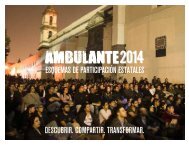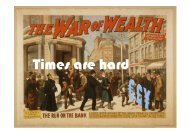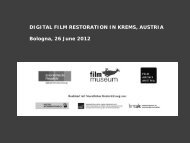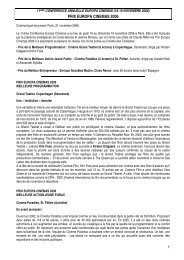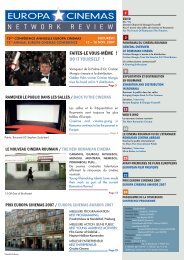Supplément du Film français - Europa Cinemas
Supplément du Film français - Europa Cinemas
Supplément du Film français - Europa Cinemas
You also want an ePaper? Increase the reach of your titles
YUMPU automatically turns print PDFs into web optimized ePapers that Google loves.
22 AUDIENCE / attendance23d’être passifs au cinéma. C’est un constat que nous faisonsau Watershed, aussi bien pour les enfants que pour les a<strong>du</strong>ltes.Nous cherchons constamment à trouver des moyens de sé<strong>du</strong>irede nouveaux publics”, explique Madeleine Probst. Ce cinéma<strong>du</strong> front de mer, qui donne sur les anciens docks de Bristol,organise toute une série d’événements participatifs pour lesenfants, les adolescents et les jeunes a<strong>du</strong>ltes : <strong>du</strong> projet annuelElectric December, en passant par la projection des “meilleurscourts métrages de toute l’Europe”, organisée en lien avec leurspartenaires par le biais <strong>du</strong> réseau <strong>Europa</strong> <strong>Cinemas</strong>, jusqu’àl’action Future Pro<strong>du</strong>cers pour les 16-25 ans qui consiste àfaire programmer par un groupe de jeunes a<strong>du</strong>ltes Fresh Flix,un cycle <strong>du</strong> cinéma destiné aux enfants et à la jeunesse. AuErnest et Célestine, filmd’animation françaisdont les projectionsont été suiviesd’ateliers d’illustration.French feature-lengthanimation “Ernestand Celestine” wasscreened alongside anillustration workshop.programme cet automne : la projection, le soir d’Halloween,des Noces funèbres de Tim Burton, agrémentée en journée d’unatelier “défunts pantins” ; un film d’animation français, Ernestet Célestine, associé à un atelier d’illustration ; et le film danoisMon tonton, ce tatoueur tatoué, suivi d’un atelier tatouages.L’atelier de la conférence de novembre permettra de poursuivreles discussions entamées lors de la rencontre <strong>Europa</strong> <strong>Cinemas</strong>dédiée aux jeunes publics que le Festival <strong>du</strong> cinéma de patrimoinede Bologne, Il Cinema Ritrovato, accueille tous les ansau mois de juin. Le débat a beaucoup évolué depuis le lancementde l’événement en 2005, d’après Ian Christie. “Quandnous avons lancé le séminaire de Bologne il y a environ sixans, il y était surtout question de la programmation commed’un outil principal pour tenterd’attirer les jeunes, explique-t-il.Aujourd’hui, nous parlons toujoursde programmation, mais ce qui achangé, c’est qu’on discute surtoutdes activités qui accompagnent laprogrammation. Il ne suffit pas deleur balancer des informations, ilfaut surtout tenter d’instaurer un© Studiocanallack of European titlesfor young audiencesThe latest Bologna meeting included talks by British MuffinHix on the travelling pop-up venture The Lost Picture Show,and Swedish Louise Leghammar on The Backyard, a cinemaclub initiative, as well as a presentation on how British distributorDogwoof used the social networks to create a buzzaround its films. “The Lost Picture Show is a tent show thatgoes around music festivals. A show like that has lots offairground elements,” Christie says. “The Backyard is aboutusing a bit of space at the back of a cinema so youngsters canhang out with their friends and watch films in a more informalatmosphere.”Earlier in June, <strong>Europa</strong> <strong>Cinemas</strong> expanded the discussionbeyond Europe’s borders with the first edition of The Publicof the Future event in México City, hosted by the FestivalDistrital in coopera tion with the Cineteca Nacional, whichbrought together 35 participants from Europe and LatinAmerica. Probst says such conferences are invaluable. “It’sgreat to come together with other people in the field, to hearabout new approaches. The best ideas don’t necessarily comefrom the most resourced players either.” Alongside the confeolds,through which a group of young a<strong>du</strong>lts programmes thecinema’s children and youth-focused strand Fresh Flix. Thisfall’s line-up included a Halloween screening of “Corpse Bride”followed by a “Day of the Dead” puppet workshop, Frenchfeature-length animation “Ernest and Celestine”, alongside anillustration workshop, and Denmark’s “Tiger and Tattoos”,followed by a tattoo workshop.The workshop at November’s conference will continue thediscussions of <strong>Europa</strong> <strong>Cinemas</strong>’ annual meeting devoted toyoung audiences, hosted by Bologna’s Il Cinema Ritrovatoheritage film festival in Italy, every June. The debates haveconsiderably evolved since the event’s launch in 2005, Christiesays. “When we started doing our Bologna seminar some sixyears ago, the onus was on programming as the main toolto try and attract young people. Now we still talk about programming,but what has changed is that the emphasis is onwhat you do around the programming. It’s about establishinga form of communication with the audience. You don’t justthrow information at them, but you actually try to create adialogue. Which, of course, leads on to questions of how touse social media. It’s not enough for a cinema to simply stickits programme up on the Internet anymore.”Christie feels that the move to break down rigid screening formatsand make cinema-going a more participative experienceactually harks back to a bygone era in cinema. “When I usedto go to the cinema as a child, you never got there just forthe film—movies would play back-to-back all afternoon, andpeople would come and go. In recent years, a more church-likeapproach has developed with regards to cinema-going. Theaudience arrives before the film start, sits straight in its chair,and leaves at the end. I do think we have to question whetherthere is only one mode of showing films properly. Some ofthe initiatives we’re seeing now are doing just that, tearingdown recent perceptions of what constitutes a proper cinemagoing experience. There’s a tendency to forget that cinema isin constant evolution. After all, the first screenings were extrasin a music hall programme. There are no hard and fast rules.”un cinéma ne peutse contenter de publiersa programmation sur internet.It’s not enough for a cinemato stick its programmeup on the internet.Ian christie (<strong>Europa</strong> <strong>Cinemas</strong>)dialogue, ce qui con<strong>du</strong>it naturellement à des questions sur l’utilisationdes réseaux sociaux. Aujourd’hui, un cinéma ne peutplus se contenter de publier sa programmation sur internet.”Pour lui, cette tendance à vouloir casser les codes et faire participerdavantage le public n’est pas sans rappeler une époquerévolue. “Quand, enfant, j’allais au cinéma, on n’arrivait jamaispour le début d’un film. Ils s’enchaînaient les uns après lesautres tout l’après-midi, et les gens allaient et venaient dans lasalle. Aujourd’hui, l’attitude des spectateurs est plus proche <strong>du</strong>recueillement. Le public arrive au début de la séance, s’assiedtranquillement dans son fauteuil et repart à la fin. Je pense qu’ilfaut s’interroger sur le mode de présentation des films. Y ena-t-il un seul qui convienne ? Certaines initiatives qui se développents’attaquent à ce sujet : on remet en question la séancede cinéma en bonne et <strong>du</strong>e forme. On a tendance à oublier quele cinéma est en constante évolution. Les premières projectionsne venaient qu’en complément d’une soirée de music-hall. Iln’y a pas de règles strictes à observer.”Lors <strong>du</strong> dernier séminaire de Bologne, la Suédoise LouiseLeghammar a présenté The Backyard, un club de cinéma. Lesparticipants se sont également familiarisés avec l’utilisationdes réseaux sociaux par le distributeur britannique Dogwoofpour créer <strong>du</strong> buzz autour de ses films. La Britannique MuffinHix a aussi expliqué ce qu’est son cinéma itinérant : “The LostPicture Show, c’est une tente qui se promène d’un festival demusique à l’autre.” Ian Christie rapporte : “Muffin Hix nousa surtout indiqué comment organiser un spectacle qui fasselargement appel aux codes de la foire. The Backyard consisteà utiliser un espace à l’arrière d’une salle pour que les jeunespuissent se l’approprier et y traîner avec leurs amis pour regarderdes films dans une ambiance moins stricte.”Munro of the Glasgow <strong>Film</strong> Theatre (GFT); Iris Praefke of theMoviemento (Berlin); and Madeleine Probst, the innovativeprogramme developer of the Watershed cinema in Bristol. TheWatershed, which won <strong>Europa</strong> <strong>Cinemas</strong>’ Best Entrepreneurprize in 2010, is perhaps one of the most proactive venuesin the network when it comes to attempting to connect withyoung audiences.“Digital technology is challenging existing models and changingthe relationships between cultural venues, such as cinemas,and audiences. We’re well aware we’re working in anenvironment where consumers aren’t going to accept the passiveexperience of just sitting in a cinema anymore… that goesfor children as well as a<strong>du</strong>lts – it’s at the core of what we doat the Watershed. We’re constantly looking at new ways ofengaging new audiences”, Probst says.The waterfront cinema, overlooking Bristol’s in<strong>du</strong>strial docks,runs a range of participative events for children, teenagersand young a<strong>du</strong>lts from the annual Electric December project,showcasing the “best short films from across Europe”, which itpulls together with the help of its contacts within the network,to the Future Pro<strong>du</strong>cers initiative, aimed at the 16-to-25-year-manque de films européenspour le jeune publicDébut juin, <strong>Europa</strong> <strong>Cinemas</strong> a exporté le débat par-delà lesfrontières européennes lors la première édition de The Publicof the Future (Le public de demain), à Mexico, dans le cadre<strong>du</strong> Festival Distrital, en association avec la Cineteca Nacionalde México. Trente-cinq professionnels venus d’Europe, <strong>du</strong>Mexique et d’Amérique latine étaient présents. Pour MadeleineProbst, des séminaires comme celui de Bologne ou la toutedernière, qui s’est tenue au Mexique, sont essentielles. “C’estpassionnant de rencontrer d’autres personnes qui travaillentsur le terrain, d’entendre parler de nouvelles approches. Lesmeilleures idées ne proviennent pas forcément des acteursayant les plus gros moyens.”Parmi les actions visant le jeune public figure le projet27 Times Cinema (en partenariat avec le Parlement européen,les Venice Days et Cineuropa) qui prend en charge 27 jeunescinéphiles, un par pays membre de l’Union européenne, afin deleur permettre d’assister aux projections de la Mostra de Veniseet de rencontrer des réalisateurs et des professionnels <strong>du</strong> cinéma.Au-delà des questions de forme, des manières de présenterles films dans les salles, et des actions visant à faire venir lesplus jeunes au cinéma, un autre sujet est primordial : celui <strong>du</strong>manque de films européens s’adressant à ce jeune public. “Ilest difficile de trouver des œuvres européennes qui sé<strong>du</strong>isentle jeune public. Outre les barrières culturelles et linguistiques,c’est surtout le problème <strong>du</strong> fonctionnement de la pro<strong>du</strong>ctioneuropéenne qui se pose. Nous ne pro<strong>du</strong>isons pas de films quis’adressent à la famille comme le font les Américains. Le filmde famille américain, un pro<strong>du</strong>it qui sé<strong>du</strong>it petits et grands, estun des grands succès de leur in<strong>du</strong>strie cinématographique.En Europe, on est beaucoup plus rigides et on cherche plutôtà savoir si cela convient aux enfants plutôt qu’à se demandersi ça les intéresse vraiment. C’est un autre sujet qui mériteraitun vrai débat”, conclut-elle. ❖rences and subsidies, other <strong>Europa</strong> <strong>Cinemas</strong> youth-focusedinitiatives include the 27 Times Cinema project (in partnershipwith the European Parliament, Venice Days and Cineuropa),taking 27 young film buffs, one for each of the member states,to the Mostra to attend screenings and talks with directorsand professionals. Beyond the question of how films shouldbe presented and what can be done to encourage children andyoung people into the cinema, another issue prevails in termsof getting young audiences to watch non-national Europeanpro<strong>du</strong>ctions across the region—namely, the lack of such titles.“It’s more difficult to find European films which appeal toyoung audiences in several territories. Aside from the languageand cultural issues, the main one is that Europeanpro<strong>du</strong>cers just don’t make family films in the same way as theAmericans do. Young people’s cinema is essentially American.The American family film – a pro<strong>du</strong>ct for everyone, children,teenagers and a<strong>du</strong>lts alike – is one of the triumphs of the USfilm in<strong>du</strong>stry. In Europe, we’re a lot more rigid and tend to getcaught up in questions of whether something is suitable forchildren rather than whether it is interesting for children. It’sanother issue which really needs some serious debate,” sheconcludes. ❖<strong>Europa</strong> <strong>Cinemas</strong> 20 e anniversaire<strong>Europa</strong> <strong>Cinemas</strong> 20 th anniversary





